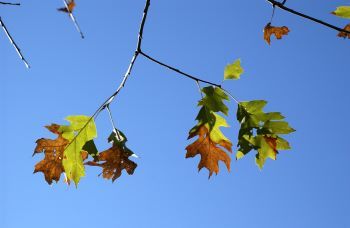|
April 14, 2023
Contact: Contact: Cheryl Nelson (Lower Peninsula), 231-287-1714; or Simeon Wright (Upper Peninsula),? 906-203-9466
Keep oak trees healthy by helping prevent oak wilt disease

During the period between April 15 and July 15, beetles actively carry spores of fungus from tree to tree, meaning oak trees are at high risk for infection with oak wilt. Oak trees with wounds in their bark are susceptible to the disease, which can weaken white oaks and kill red oaks within a few weeks.
?Oak trees should not be pruned between April 15 and July 15. These pruning guidelines can help keep infection from spreading,? said Simeon Wright, forest health specialist in the DNR?s Forest Resources Division. ?Once a tree is infected there is no cure. Without expensive treatments the disease spreads to other trees and may in time kill all nearby oaks.?
If you have an oak tree that gets damaged during the high-risk period from April 15 to July 15, immediately cover all wounds with tree-wound paint or latex-based paint. Painting tree wounds is not recommended for other trees species as it can reduce the effectiveness of the healing process.
Besides being carried by the nitidulid beetle, which is active in spring and early summer, oak wilt also can spread from tree to tree through roots that are grafted, or grown together underground. Spores also can be carried long distances to living trees when you move firewood cut from an infected tree and beetles pick up the spores.
|
 Oak wilt can kill some oaks within weeks
First identified in the Midwest during the 1940s, oak wilt was confirmed in Michigan in the early 1950s and now is common in the Lower Peninsula. It also has been identified in Menominee, Dickinson and Iron counties in the Upper Peninsula. Trees in the red oak family are most susceptible to the disease. These include black oak, northern red oak and northern pin oak -- all have leaves with pointed tips. Trees in the white oak group have rounded leaf edges and include white oak, swamp white oak, and bur oak. These trees are better able to block spread of the disease through the entire tree, preventing rapid death.
Symptoms of oak wilt most often appear from late June until September. Affected trees will suddenly begin to wilt from the top down, rapidly dropping leaves, which can be green, brown or a combination of both colors. Left untreated, oak wilt will continue to move from tree to tree through grafted root systems, killing more red oak over an increasingly large area when oaks grow close together. As more trees die from oak wilt, more fungal spores are produced, which allows the beetle to carry the infection to new locations.
Firewood cut from infected trees can harbor the fungus, so don?t move firewood from one place to another. If you suspect your firewood is infected by oak wilt, you can help slow the spread by burning it, chipping it or debarking it before April. Once the firewood has been dried for longer than a year and/or all the bark loosens, the firewood can no longer spread oak wilt.
To minimize the risk of oak wilt infection caused by logging damage, the DNR restricts cutting of red oak trees on state land between April 15 and July 15. The DNR recommends private forest landowners exercise caution during this period and, whenever possible, delay harvests in oak forests until after July 15.
If you suspect a tree has oak wilt?
Note to editors: Accompanying photo is available below for download. Caption information follows.
-
Oak wilt: A tree affected by oak wilt has lost its leaves from the crown down. Oak wilt can quickly kill trees in the red oak family. The fungus can be carried by beetles during the spring and summer, so don't prune trees from April 15-July 15 to protect them from disease.
|